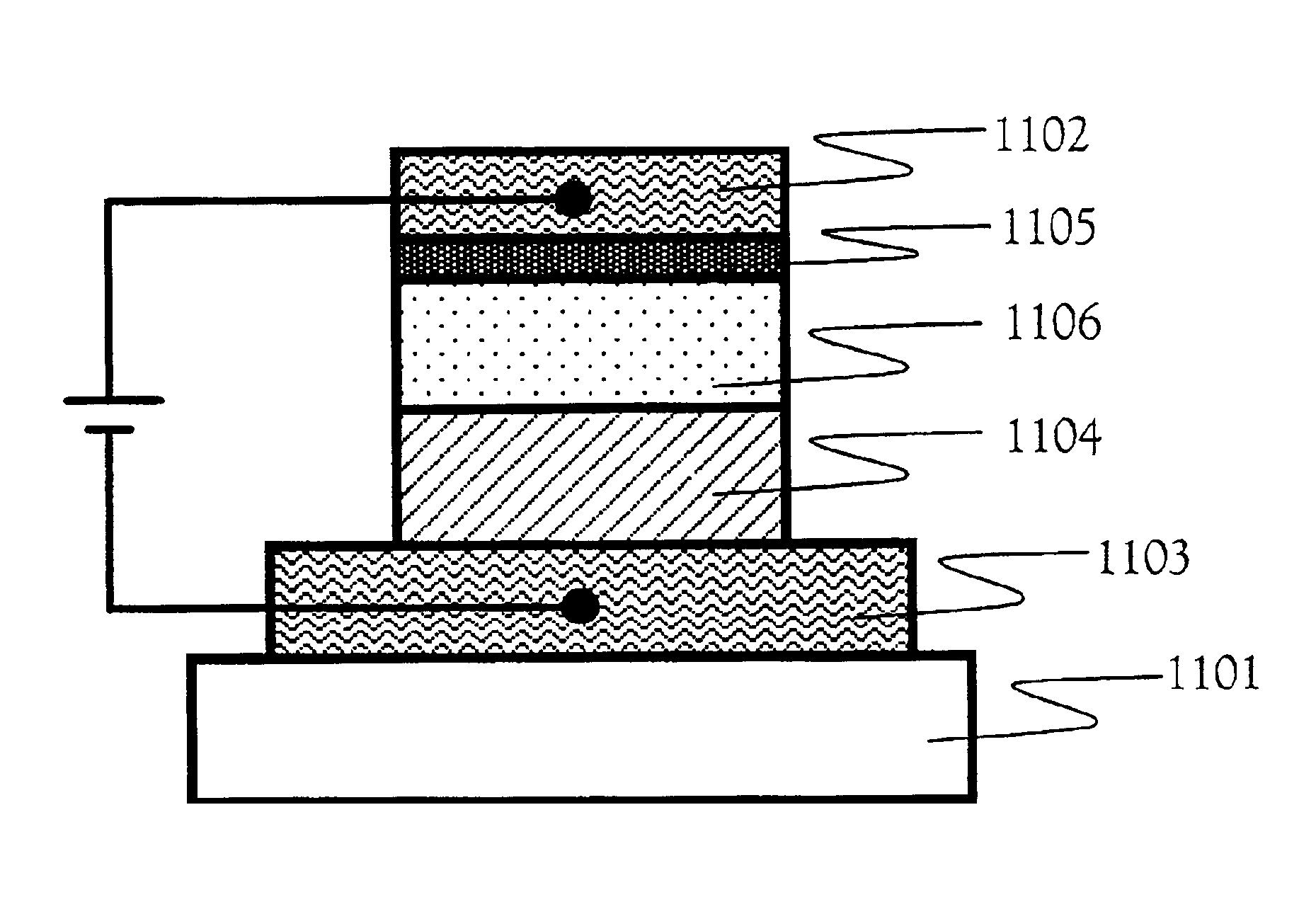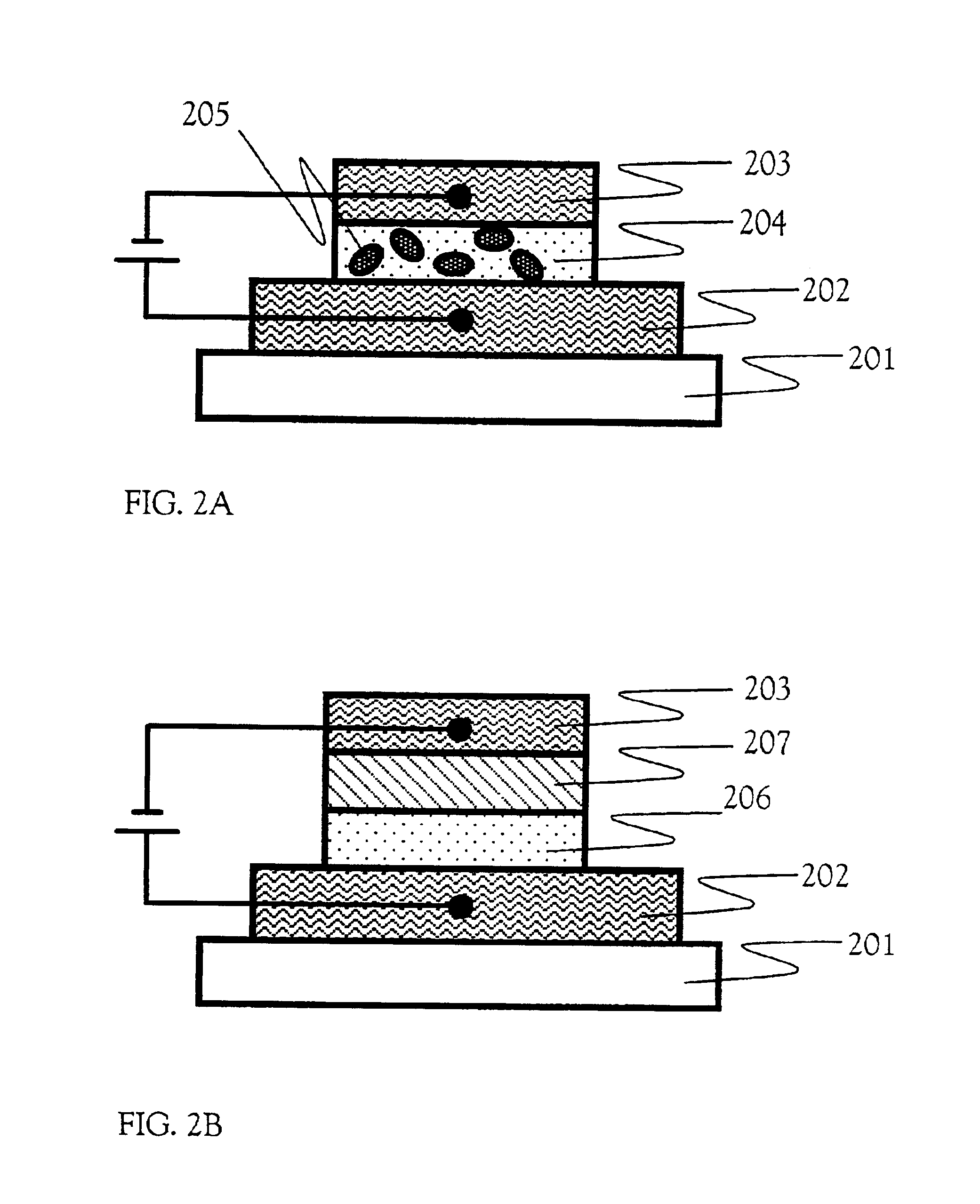Light emitting device
a technology of light-emitting devices and light-emitting devices, which is applied in the direction of discharge tube luminescnet screens, natural mineral layered products, etc., can solve the problems of waste of material that is not deposited on the target but adheres to the inner side of the chamber, is not cost-effective by any means, and the size of the substrate is affected, so as to improve the light-emitting efficiency of organic el elements and improve heat resistance and mechanical characteristics. s
- Summary
- Abstract
- Description
- Claims
- Application Information
AI Technical Summary
Benefits of technology
Problems solved by technology
Method used
Image
Examples
embodiment 1
[Embodiment 1]
[0082]This embodiment specifically exemplifies a polymer material expressed by the general formula 1 according to the embodiment mode of the present invention, and the description is also directed to production of an organic EL element using the polymer material. For the structure of the element, the structure shown in FIG. 1C is used.
[0083]The polymer material used in this embodiment is a metal-containing polymer having platinum as a central metal of a porphyrin skeleton (hereinafter referred to as a “Pt polymer”) and is expressed by the following constitutional formula 3.
[0084]Among low molecular weight materials, the platinum complex described in Reference 2 has the porphyrin skeleton and is an organic material that can convert triplet excitation energy into emission light. In Reference 2, however, the platinum complex is used as a dopant. Hence, in the present example, it is considered suitable that the Pt polymer is used as a dopant to disperse in a matrix polyme...
embodiment 2
[Embodiment 2]
[0088]This embodiment specifically exemplifies a polymer material expressed by the general formula 2 according to the embodiment mode of the present invention. In this embodiment, the description is also directed to production of an organic EL element using the polymer material. For the structure of the element, the structure shown in FIG. 2B is used.
[0089]The polymer material used in this embodiment is a metal-containing polymer having palladium as a central metal of a phthalocyanine skeleton (hereinafter referred to as a “Pd polymer”) and is expressed by the following constitutional formula 4.
[0090]Among low molecular weight materials, a phthalocyanine compound is often used for a hole injecting layer. As shown in FIG. 8, this embodiment is directed to an example in which a Pd polymer 804 is deposited as a hole injecting layer on an anode 802 and further a light emitting layer 805 is laminated thereon. For the light emitting layer 805, known light emitting materials...
embodiment 3
[Embodiment 3]
[0092]In this embodiment, the description is directed to production of the organic EL element shown in FIG. 3 according to the embodiment mode of the present invention. Since the polymer to be doped is located on the anode side, known hole injection materials may be used including polyaniline (hereinafter referred to as “Pani”) and a polythiophene derivative (hereinafter referred to as“PEDOT”). Here, the PEDOT is used. In addition, iodine is used as the dopant for the PEDOT and PPV is used for the light emitting layer.
[0093]The element structure is shown in FIG. 9. The following production method is employed. That is, initially the PEDOT is deposited on an anode 902 and then is brought into contact with iodine vapor for a few hours. Thus, an iodine-added PEDOT 904 is obtained. Afterward, vacuum degassed is carried out to remove unreacted iodine, and then PPV 905 as a light emitting layer is deposited on the iodine-added PEDOT 904. Finally, a cathode 903 is deposited by...
PUM
| Property | Measurement | Unit |
|---|---|---|
| internal quantum efficiency | aaaaa | aaaaa |
| external quantum efficiency | aaaaa | aaaaa |
| external quantum efficiency | aaaaa | aaaaa |
Abstract
Description
Claims
Application Information
 Login to View More
Login to View More - R&D
- Intellectual Property
- Life Sciences
- Materials
- Tech Scout
- Unparalleled Data Quality
- Higher Quality Content
- 60% Fewer Hallucinations
Browse by: Latest US Patents, China's latest patents, Technical Efficacy Thesaurus, Application Domain, Technology Topic, Popular Technical Reports.
© 2025 PatSnap. All rights reserved.Legal|Privacy policy|Modern Slavery Act Transparency Statement|Sitemap|About US| Contact US: help@patsnap.com



